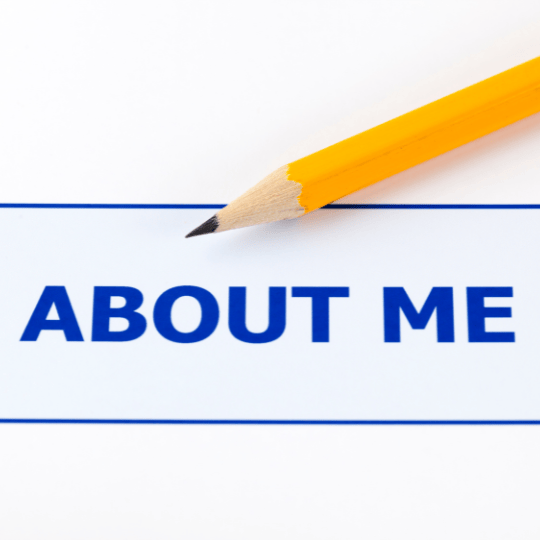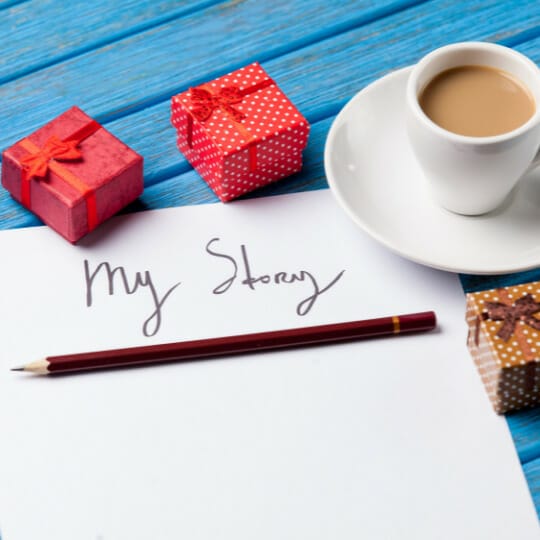
Do you want to attract more clients to your business – and the RIGHT kind of clients?
As part of my Passion to Profit course, I ask my students to write an About Me story as a critical part of their marketing. In this episode, I’ll explain how to write it in a way that attracts the right kinds of clients more easily, and with fewer objections.
Statistics show that your About Me story is one of the most-read pieces of content on your website.
So, what is an about me story?
It’s the story that describes your journey from tragedy to triumph, to arrive at where you are today.
It is an emotive story that captures four important things:
In his 2015 book called Dotcom Secrets, founder of Clickfunnels Russell Brunson describes this as an Attractive Character Avatar – a public persona that people immediately relate to and connect with.
Why does the about me story matter?
Well, because first impressions count and your About Me page is often the first thing people look for on your website. A well-written story builds connection, rapport and trust with the reader.
Statistics show that your About Me story is one of the most-read pieces of content on your website.
So, what is an about me story?
It’s the story that describes your journey from tragedy to triumph, to arrive at where you are today.
It is an emotive story that captures four important things:

In his 2015 book called Dotcom Secrets, founder of Clickfunnels Russell Brunson describes this as an Attractive Character Avatar – a public persona that people immediately relate to and connect with.
Why does the about me story matter?
Well, because first impressions count and your About Me page is often the first thing people look for on your website. A well-written story builds connection, rapport and trust with the reader.
Remember that people buy you, not your service. There are four things that your About Me story must cover in order to build trust and rapport with the reader. It must show the reader:
Think about how much trust that generates!
Think about any more generic About Me story that you’ve read on a website or one that is full of qualifications.
How did you feel when you read it?
A dry, boring, linear account of your academic history can cause readers to skim at best, and switch off at worst.
Yes, qualifications matter, but it’s personal engagement that actually sells.
By telling a heartfelt, emotive story of tragedy to triumph, the reader will see themselves in your words.
They’ll know that you ‘get’ how they are feeling.
They’ll get to know you a bit more personally and understand your personality, values and approach.
By the end of your relatable story, the reader should be clear about how aligned they are with you, and whether you are the right person to help them or not.
In other words, a well-written story can either attract or repel the reader – so you end up with enquiries from people who are pre-sold that you might be a good personality fit for them – and very few mismatches or tyre kickers!
Start by doing some exercises to prepare to write your story.
If you haven’t had a journey yourself, you might have had experience with many clients in a niche, or friends and family around you with a certain problem.
Your About Me story can convey your story, OR your experience with others.
You might like to think about and write some notes about:

Once you have done this, you probably have all the elements to write a great story about a journey that you or others have had.
It needs to be real, emotive and compelling.
Here are some tips for getting it right.
(1) Start with a defining event
You can draw the reader in with a specific event that triggered a chain reaction.
For example:
“The year I turned 35, I was living my best life. I was travelling extensively for work, partying hard, and playing golf and tennis. Then I married my best friend and we knew we wanted to have kids right away. It would be the icing on the cake of a perfect life.
But after 6 months of trying, we were unable to get pregnant, and it was then that I was diagnosed with polycystic ovarian syndrome (PCOS).
Suddenly my world collapsed, and we were faced with some hard decisions about what to do. We were facing expensive treatment, a hormonal rollercoaster, and no guarantee of success.”
Notice in that example, I outlined how good life was, and how this one specific event was so big that it stopped the person in their tracks.
It covered specific events in a timeline and described all the emotions that were felt along the way. Remember, this could be your story or the story of a client who came to you for help and succeeded (written in the third person).
This part helps the reader connect with you as a person on a similar journey, or who has helped people like them. It is where resonance and trust start.
Are you someone that they could relate to and work with?
(2) Define the emotional turmoil
Next, you want to talk about the pain of this – the cost of the struggle. This highlights the personal reasons why getting help and seeking a solution are so important. In doing this, you get to share your values and motivators, which might be the same as your client.
For example:
“We were told by the specialist that if I went ahead with treatment, life would change dramatically. I would need time off work and our income would drop.
I would have to deal with uncomfortable side effects of the treatment. It would make me more emotional, and it would change my body.

My husband and I talked about the consequences. He would have to be the main income earner, and on top of that, I would be relying on him for more emotional support.
We would have to decide whether we really wanted kids badly enough to go through with these massive changes and this uncertainty.”
Notice in this example, I am talking about that initial stage of diagnosis and talking about things that the reader with this problem might be going through. The reader who relates to this would be thinking – YES – this person gets it!
This part helps the reader connect with their version of the problem, and to weigh up how big of a problem something is for them right now.
Is the reader going through this too, and are they ready to make a decision?
(3) Describing the turning point
Whenever there is a problem that someone is facing, they weigh up the pros and cons of change and before deciding what to do, as we heard in that last point.
Humans are driven to avoid pain, so when there are more benefits to change than not, it creates the motivation to act and seek help.
Describing the decision-making and action in detail – what you realised, what was decided, how it felt and what the next steps were – helps your reader to make their own decision, and get some ideas on what getting started might look like.
It also gives them ‘permission’ to ask for help. After all, if a competent role model like you sought help – then the reader might be able to do it too!
On the other hand, what happens if you were to write about how you did it all yourself? It might be off-putting for the reader. They might feel that it’s too hard, or they’re not good enough to do it themselves!
If you manage to weave in the importance and value of getting support, it could help the reader to find the courage to reach out to you. This is important from a marketing perspective (not so much the resonance of the story itself).
For example:
“Being undecided was an excruciating place to be. We needed to make a decision one way or the other, and we both felt so much pressure to choose the right option – but we had no idea what it was! We had so many unanswered questions.
How would we pay for the expensive treatment?
Were we up for this, financially and emotionally?
Could our marriage handle it?
Or could we face a life without kids?
What would that look like?
As our next specialist appointment drew nearer, we decided to go for it. But it would be hard on our own and between specialist visits. I would need to make sure I was doing everything possible to make my body healthy and better equipped to handle potential pregnancy.
My specialist recommended a health coach who specialised in optimising health for women trying to fall pregnant.
She was amazing – not just in helping me be consistent with positive habits like eating well and exercising safely, but also with the emotional support I needed. She helped me to set boundaries at work so I could finish earlier, get more rest, and also accept that I needed to slow down!
I have achieved so much in so many areas of my life, but without the support of my coach and the community she offered, I would have truly struggled with so many things.
Notice in this example, I am talking about the fear and questions, the process for getting support, and how the support benefitted the person.
This part helps the reader to understand that help is available, and how it helps them get through this situation. It helps to generate hope and optimism, relief and other positive emotions.
(4) Amplifying the outcome
Change is hard, and it is often a struggle. It requires focus, dedication and persistence, and to set time aside.
A person will only go through that if there is a reward at the end – and if it’s the reward they want.
Your ability to articulate that clearly, at the end of your About Me story, is essential for helping someone feel ready, willing and able to change – and that you are the right person to help them.
If your reasons and benefits are the same as theirs, they will likely reach out to you for help.
For example:
“Fast forward two years, and we have an amazing little girl who is healthy and happy. We managed to fall pregnant on the second round of treatment, and my coach was invaluable in helping me keep my physical and mental health in check.
I went on to study Health and Wellness Coaching because I wanted to help women like me who were taking that leap of faith, to do so with their best foot forward.
And even though I’m a qualified coach now with a Professional Certificate of Health and Wellness Coaching, I still check in with my coach every 2 – 3 months. I am healthier than I’ve ever been, thanks to her ongoing support.
Right now, she is that objective, non-judgemental person who helps me to navigate the challenges and the joys of raising a baby while running my business. She helps me make better decisions and to be consistent with the habits that keep me healthy and happy.
I have been working with my own clients for 12 months now and am so excited to be doing this important work.
I am so excited and relieved that things worked out. Finally, we got the family we wanted, and we were even talking about baby number 2! For us, making this decision was the best thing we’ve ever done.
If you are reading this story and going through this right now – please take your time to think about all the angles of your decision.
And if you have taken that deep breath and decided to go for it – please know that there are people who can support you and help you through it, regardless of the outcome.”
This part fast forwards to the joy and reinforces the benefits and importance of getting help. It speaks to what’s possible, helps them to connect with the desired outcome, whether you are the right person, and once again, to work out if they are ready, willing and able to do the work.
Today we discussed what an About Me story is, why it matters, and four things it must cover.
If you get it right, you will build trust and attract the right clients to your business, and they will be ‘pre-sold’ that you are the right person to help them.
There are four parts of a magnetic About Me story:
If you need help writing an About Me story, book a good fit call to see if I can help you. My books are closed to personal clients until July 2022, but I have space in my June Passion to Profit program if you need help building the foundations of your business. Click the link to learn more about the program.
Understanding who you are and what you need will allow your business to thrive! If you’re truly ready to break old habits and get out of the rut I encourage you to check out the Habitology membership.
Learn more here:
© 2024 Melanie White